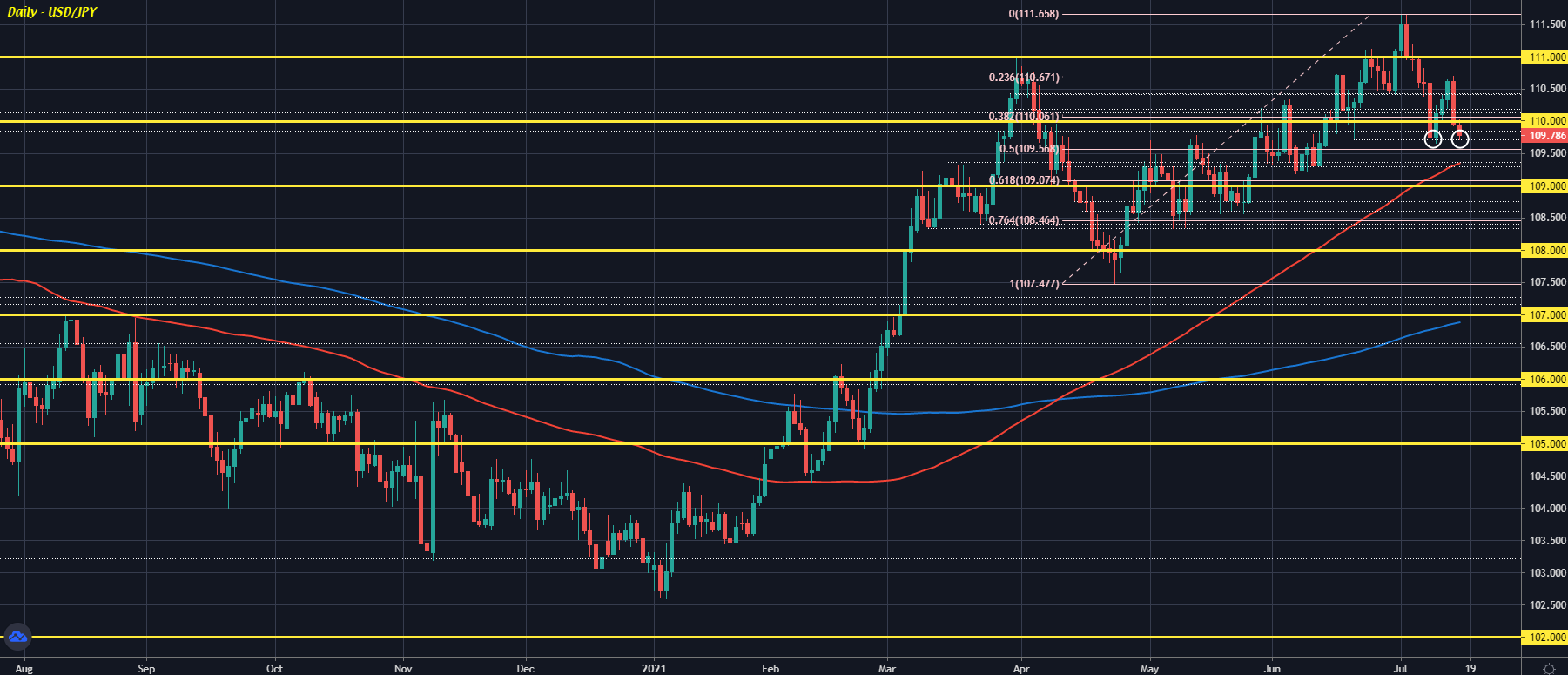Even if this short-term crash happens later this year, I still think SPX is going to recover and hit new ATHs (~ $5000) in order to form negative divergence with its AD Line — that’s how all major tops have been formed in the past (on negative divergences).
Latest Posts
rssThought For A Day

USD/JPY keeps on the defensive amid lower yields
USD/JPY down 0.2% at 109.75

With Treasury yields keeping lower on the day, it is seeing the yen hold firmer ground so far in European morning trade as USD/JPY keeps below 110.00.
The low today hit 109.72 and that nears a test of daily support from the 21 June low @ 109.71. That will be a key level to watch ahead of the close before the 50.0 retracement level @ 109.57 comes into play again – as we saw last week.
There hasn’t been a coherent theme in the market in trading this week with equities and bond yields bouncing higher earlier only to see a retreat over the past day or so.
In particular, 10-year yields have come off the high around 1.42% on Tuesday to fall just below 1.32% currently in European morning trade today.
Going back to USD/JPY, as price action continues to tussle around this area, the 100-day moving average (red line) – now seen @ 109.35 – will also draw closer and may play a key technical role in dictating which direction the pair moves next.
Tomorrow’s US retail sales data may be a catalyst for a move so just be wary of that.
China Q2 GDP 1.3% q/q (expected +1.2%)
China Q2 GDP 1.3% q/q (expected +1.2%, prior 0.6%)
- For y/y +7.9% ( expected 8%, previous 18.3%.)
Goldman Sachs is bullish on oil following the reports of a Saudi/UAE deal
Oil prices have dropped away since the reports that Saudi Arabia and the United Arab Emirates have reached a compromise over OPEC+ policy.
The deal should unlock an increased supply of crude into a tight oil market.
Justin was on top of the news as it broke yesterday:
- Saudi Arabia, UAE reportedly reach compromise over oil output deal
Goldman Sachs say that the expected OPEC+ deal would be a bullish catalyst. The firm has maintained its Brent forecast at $80 per barrel.
South Korea’s central bank has left its key rate unchanged at 0.5% (as expected)
Bank of Korea July monetary policy meeting.
The renewed surge of COVID-19 infections in SK (across Asia too) has made the BoK wary of the uncertainties this introduces.
Reports are the US-Iran nuclear talks will not resume until mid-August
A resolution of these talks would (in time) lead to Iran supplying more oil.
But, that looks a way off if these latest headlines are accurate.
Reuters report, citing an unnamed diplomatic source:
- Iran won’t resume talks until its new president takes over
- Iran has conveyed this timing to European particiapants
- talks unlikely to resume before the middle of August
The Fed Beige Book sees further price rises in the US
The “Beige Book” is more properly known as the “Summary of Commentary on Current Economic Conditions by Federal Reserve District”
- its published eight times per year
- Each Federal Reserve Bank gathers anecdotal information on current economic conditions in its District through reports from Bank and Branch directors and interviews with key business contacts, economists, market experts, and other sources.
- The Beige Book summarizes this information by District and sector.
- An overall summary of the twelve district reports is prepared by a designated Federal Reserve Bank on a rotating basis.

Not too much time left for #Bitcoin to hit 350,000$
BOC tapers, Powell preaches patience
Markets:
- Gold up $19 to $1827
- US 10-year yields down 6.6 bps to 1.349%
- WTI crude down $2.52 to $72.73
- S&P 500 up 5 points to 4374
- NZD leads, USD lags
It was a packed day of news but it didn’t translate into a straight-forward day of trading. No single theme or news item captured the market’s imagination. Early on, Powell’s words boosted the risk trade and weighed on the dollar but that faded later.
In Canadian dollar trading, the market clearly wanted more in terms of tapering or positioning the BOC for earlier rate hikes but it didn’t come. Macklem stressed higher confidence in the recovery and bumped up growth forecasts but the timeline on the output gap closing stayed in H2 and the loonie fell. Sinking oil prices after looser US inventory data also didn’t help.
USD/JPY was weighed down as the bond market came back to life. Yields were persistently pressured, perhaps with the Democrat’s infrastructure plan to be paid for. Powell’s lack of urgency on inflation was another culprit.
The antipodeans managed to hold onto earlier bids after the RBNZ taper surprise. Aside from oil, commodities were solid.
The euro staged somewhat of a recovery after yesterday’s rout. That’s the name of the game at the moment with few lasting trends as we sort through the summer doldrums.



